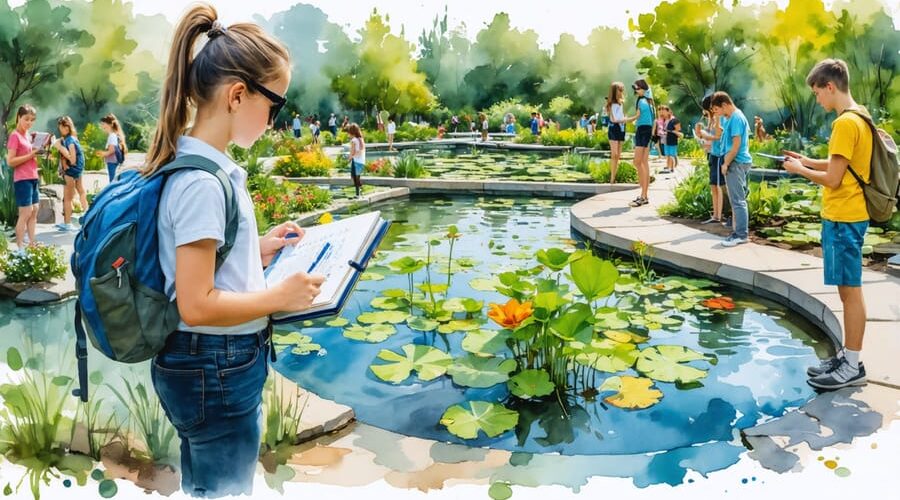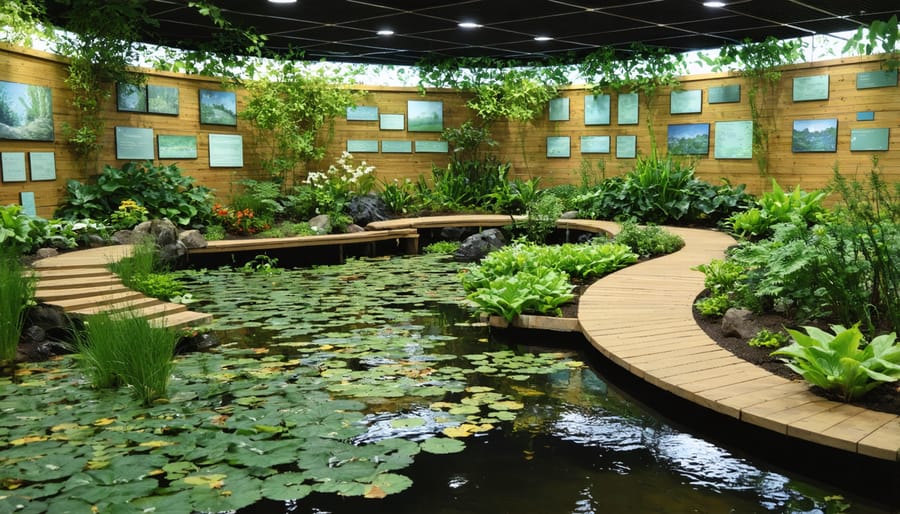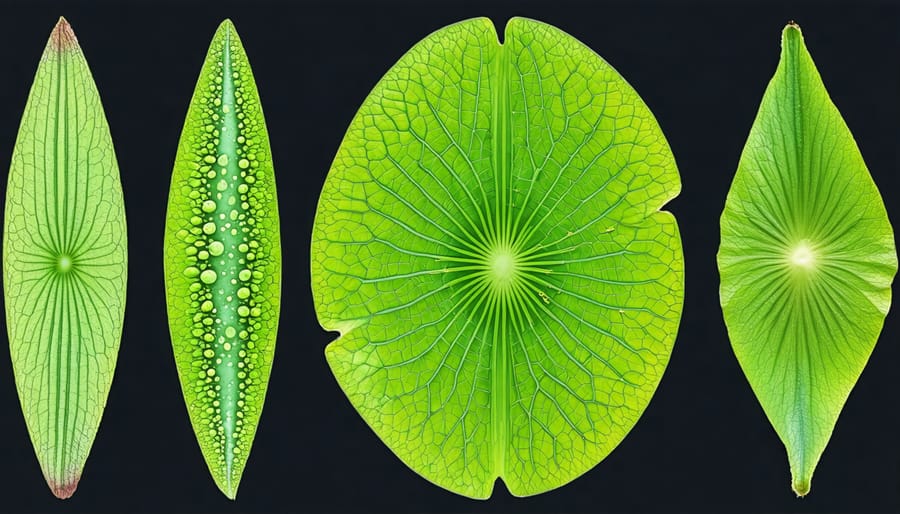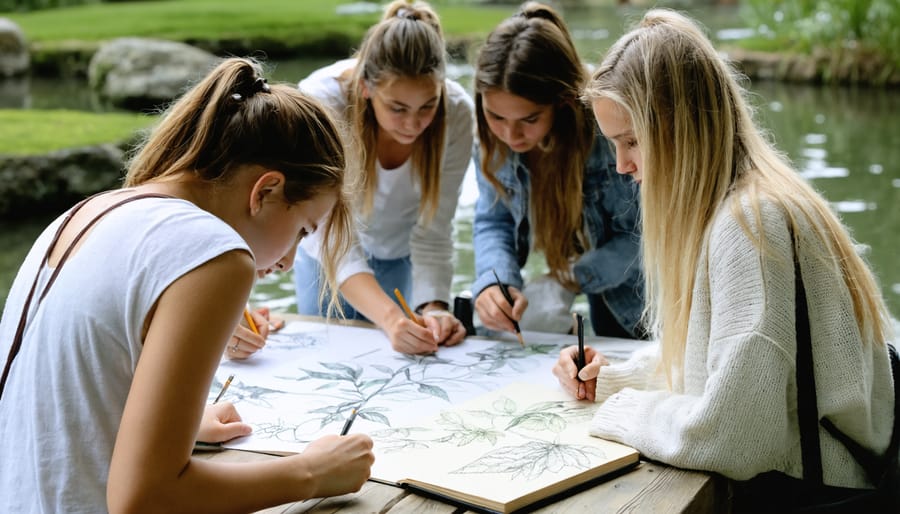
Transform Your Water Garden into a Living Classroom: Plant ID Made Easy
Transform your botanical garden into a vibrant outdoor classroom where visitors of all ages discover the wonders of plant life through hands-on learning experiences. Botanical gardens offer unique opportunities to combine formal education with the natural world, creating memorable experiences that spark curiosity and foster environmental stewardship.
From identifying rare species to understanding complex ecosystems, these living museums serve as perfect settings for both structured lessons and spontaneous discoveries. Whether you’re a garden educator developing new programs or a garden enthusiast looking to share your knowledge, botanical gardens provide the ideal environment for connecting people with plants.
The key to successful botanical garden education lies in creating engaging, multi-sensory experiences that appeal to diverse learning styles. Through carefully crafted programs, visitors can explore plant adaptations, learn about conservation efforts, and discover the vital relationships between plants and their environment. Interactive elements like guided tours, hands-on workshops, and seasonal demonstrations bring botanical concepts to life, making complex scientific principles accessible to everyone.
By combining traditional teaching methods with immersive garden experiences, botanical garden education programs cultivate not just knowledge, but a lasting appreciation for the plant world and its critical role in our lives.
Setting Up Your Water Garden Learning Space
Creating Plant Identification Zones
Creating clear plant identification zones helps visitors understand and appreciate different plant categories in your botanical garden. Start by dividing your garden into distinct areas based on plant types, such as floating plants, marginals, and deep-water plants. Use weatherproof signs or markers to label each zone clearly.
Consider creating viewing platforms or designated observation spots where visitors can safely get close to the plants without disturbing them. Install raised walkways or stepping stones to make each zone accessible while protecting delicate plant life.
Color-code your zones to make navigation intuitive – for example, use blue markers for deep-water plants and green for marginal plants. Place educational panels at the entrance of each zone explaining the basic characteristics of plants in that category and their role in the ecosystem.
Remember to leave enough space between zones for comfortable movement and group gatherings. This spacing allows educators to gather small groups for detailed discussions without blocking pathways. Consider incorporating seating areas where visitors can pause to observe and take notes during guided tours or self-directed learning sessions.
Keep maintenance paths separate from visitor areas to ensure easy access for garden care while maintaining a professional appearance for educational activities.

Essential Tools for Plant Study
To make your plant identification workshops a success, you’ll need a few essential tools at your disposal. Start with a quality hand lens or magnifying glass (10x magnification is ideal) for examining small plant features like leaf veins and flower parts. A sturdy field notebook and waterproof pen are must-haves for recording observations and sketching specimens.
Basic collection tools including pruning shears, collection bags, and plant press materials help preserve specimens for further study. Don’t forget to have several reliable plant identification guides specific to your region – both comprehensive field guides and simpler pictorial guides work well for different skill levels.
For group sessions, consider having multiple sets of basic measuring tools like rulers and calipers. A digital camera or smartphone with a good macro lens capability helps document findings and create reference materials. If you’re working with aquatic plants, include collection nets and clear containers for examining specimens.
Finally, provide participants with simple identification worksheets and botanical terminology guides to help them develop their plant ID skills systematically. Having these tools readily available ensures everyone can fully engage in the learning experience.
Hands-On Plant Identification Techniques
Key Plant Features to Study
When studying plants in a botanical garden, start with the basics of leaf observation. Notice how leaves come in various shapes – from heart-shaped to needle-like, and arrangements – from alternate to opposite patterns. Look for unique features like serrated edges, smooth margins, or compound leaves with multiple leaflets.
Flower structures offer fascinating learning opportunities. Examine the number and arrangement of petals, which can tell you about plant families. Count the stamens (male parts) and look for the pistil (female part) in the center. Notice how some flowers cluster together while others stand alone, and how their shapes might attract specific pollinators.
Growth patterns reveal how plants adapt to their environment. Observe how some plants grow straight up while others vine or spread. Pay attention to branching patterns – some are symmetrical, while others follow more random arrangements. Look for signs of seasonal changes, like new growth, flower development, and seed formation.
Take time to study plant adaptations too. Notice how some leaves are waxy to prevent water loss, while others might be fuzzy to protect against insects. Water garden plants often have special features like floating leaves or air pockets in their stems. Making these observations helps build a strong foundation in plant identification and understanding plant survival strategies.
Remember to document what you observe through sketches or photographs, which helps reinforce learning and creates a valuable reference for future study.

Common Water Plant Families
When exploring water gardens, understanding aquatic plant families is key to creating a thriving ecosystem. Let’s discover the most common groups you’ll encounter in botanical gardens!
Floating plants like water lilies (Nymphaeaceae) and lotus (Nelumbonaceae) are often the stars of the show, with their stunning flowers and broad leaves that rest on the water’s surface. These beauties help shade the water and provide shelter for pond inhabitants.
Emergent plants, including cattails (Typhaceae) and rushes (Juncaceae), grow along the edges and stand tall above the water. They’re excellent natural filters and create wonderful habitats for wildlife. You’ll often spot dragonflies perching on their stems!
Don’t overlook submerged plants like Hornwort (Ceratophyllaceae) and Elodea (Hydrocharitaceae). Though they live beneath the surface, these underwater champions are vital for oxygenating the water and supporting aquatic life.
Marginal plants such as iris (Iridaceae) and pickerelweed (Pontederiaceae) thrive in shallow water and boggy areas around the pond’s edge. They add vertical interest and help create a seamless transition between water and land.
Each family plays a unique role in maintaining the pond’s balance, making them fascinating subjects for garden education programs.
Seasonal Changes in Plant Identification
Learning to identify plants throughout the seasons is like getting to know old friends in different outfits. Each season brings unique characteristics that help us recognize our garden plants, even when they look completely different from one month to the next.
In spring, focus on emerging shoots and early growth patterns. Look for distinctive leaf shapes as they unfold and note the timing of their appearance. Early bloomers like water lilies will show their first floating leaves, while marginal plants begin pushing through the soil.
Summer is peak identification season, when most plants display their full glory. Take photos and notes of flower colors, leaf arrangements, and overall plant structure. This documentation becomes invaluable during other seasons when these obvious features aren’t present.
Fall brings subtle changes in leaf color and seed head formation. Many aquatic plants begin to die back, but their skeletal structures and seed heads are actually excellent identification features. Watch for how plants prepare for winter – some may sink below the water surface, while others remain standing.
Winter identification relies more on plant structure, bark patterns (for woody plants), and leftover seed heads. While this season can be challenging for beginners, it teaches us to look beyond obvious features like flowers and focus on fundamental plant characteristics.
Remember that many plants change dramatically underwater too. Consider keeping a seasonal photo journal to document these transformations – it’s an invaluable learning tool for both students and educators.
Interactive Learning Activities
Plant Sketching Sessions
Drawing sessions in botanical gardens offer a unique way to develop deeper connections with plants while honing observation skills. Through guided botanical sketching techniques, participants learn to notice intricate details they might otherwise miss – from the delicate venation patterns of leaves to the subtle color variations in flower petals.
These sessions typically begin with simple contour drawings, where participants focus on outlining basic plant shapes without lifting their pencil from the paper. As confidence grows, they progress to more detailed studies, incorporating shading and texture to capture the essence of water lilies, lotus flowers, and marginal plants.
What makes these sessions particularly valuable is how they slow down the observation process. When you’re sketching a water plant, you naturally spend more time studying its structure, helping you remember its identifying features more effectively. Many participants find that after drawing a plant, they can readily identify it in different settings and growth stages.
For beginners, starting with larger, more prominent features like leaf shapes works best. More experienced participants can challenge themselves by depicting smaller details like seed pods or underwater root systems. The beauty of plant sketching is that it accommodates all skill levels – it’s not about creating perfect artwork, but rather developing a more intimate understanding of plant life.

Photography Tips for Plant Documentation
Taking clear, detailed photographs of plants is essential for documentation and future reference. Start by choosing the right time of day – early morning or late afternoon provides the best natural lighting and helps avoid harsh shadows. Position yourself to capture the entire plant first, then move in closer for specific features like leaves, flowers, and stem structures.
For the sharpest images, use a tripod whenever possible, especially for close-up shots. If you’re using a smartphone, tap the screen to focus on your subject and adjust the exposure by sliding your finger up or down. When photographing water plants, try to minimize reflections by positioning yourself at a 45-degree angle to the water’s surface.
Include a ruler or common object for scale in at least one photo of each plant. This helps viewers understand the true size of the specimen. Take multiple angles of the same plant – top-down views work well for leaf patterns, while side angles better showcase plant height and growth habits.
Remember to document seasonal changes by photographing the same plants throughout the year. Label your photos immediately with the plant’s common and scientific names, date, and location. Creating a simple filing system on your computer or cloud storage will help you maintain an organized digital herbarium for educational purposes.
When sharing photos with students or visitors, select images that clearly show identifying characteristics and arrange them in a logical sequence that supports learning objectives.
Maintaining an Educational Water Garden
Seasonal Maintenance Schedule
A successful botanical garden requires careful attention to seasonal maintenance to keep plants thriving and properly labeled throughout the year. In spring, focus on removing winter protection, pruning dead growth, and updating plant identification markers that may have been damaged by frost. This is also the perfect time to divide perennials and refresh educational signage.
Summer maintenance centers on regular watering schedules, deadheading spent blooms, and controlling pest populations through natural methods. Keep identification tags visible and clean, as this is peak season for garden visitors and educational tours.
Fall activities include collecting seeds, preparing tender plants for winter, and documenting any changes in plant locations or varieties. Take time to photograph specimens in their autumn colors for educational materials and update your garden maps.
Winter tasks focus on protecting sensitive plants, maintaining indoor collections, and planning next year’s educational programs. Use this quieter season to repair or create new identification markers, update plant databases, and develop fresh interpretive materials for the coming spring.
Remember to coordinate maintenance schedules with educational activities to minimize disruptions while maximizing learning opportunities.
Adding New Species Responsibly
When adding new species to your botanical garden’s collection, focus on creating meaningful learning opportunities rather than simply increasing numbers. Start by identifying gaps in your current educational themes – perhaps you need more examples of adaptive features or plants with historical significance. Research potential additions thoroughly, considering their educational value, maintenance requirements, and how they complement existing specimens.
Create a balanced acquisition plan that prioritizes plants with strong teaching potential. Look for species that demonstrate clear botanical concepts, have interesting stories, or showcase important environmental adaptations. Consider including plants that flower at different times to maintain year-round interest and learning opportunities.
Document each new addition carefully, recording its origin, cultural significance, and educational purposes. Develop educational materials before introducing new species, ensuring they’re integrated into your teaching curriculum effectively. Consider creating themed collections that tell specific stories or demonstrate particular concepts.
Remember to maintain appropriate spacing and growing conditions for new additions. It’s better to have fewer well-maintained specimens that serve clear educational purposes than many poorly-maintained plants that don’t contribute meaningfully to your garden’s mission.
Water garden education offers a unique blend of hands-on learning, environmental awareness, and community engagement that can transform any outdoor space into a living classroom. Through plant identification workshops, participants develop a deeper connection with nature while gaining practical knowledge they can apply in their own gardens.
The benefits extend far beyond simply naming plants. Workshop participants learn about ecosystem relationships, water conservation, and sustainable gardening practices. They develop observation skills that help them become better gardeners and environmental stewards. Many find that these workshops spark a lifelong interest in aquatic plants and water gardening.
Starting your own plant identification workshop doesn’t have to be complicated. Begin with a small group of interested neighbors or garden club members. Focus on common local water plants and gradually expand your knowledge together. Document your findings with photos and simple identification guides that you can share with future participants.
Remember that learning is a continuous journey. Don’t be afraid to start small and grow your program organically. Consider partnering with local botanical gardens or horticultural societies for additional resources and expertise. The most successful workshops often grow from passionate individuals sharing their knowledge and enthusiasm with others.
Take that first step today – your water garden is waiting to become an educational sanctuary that inspires and teaches others about the fascinating world of aquatic plants.
